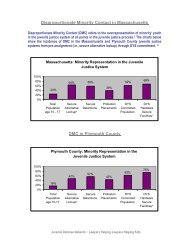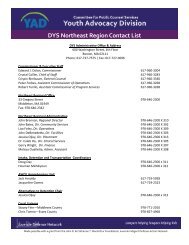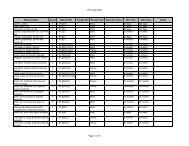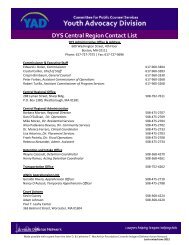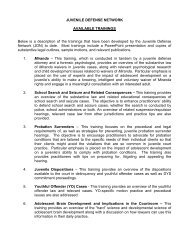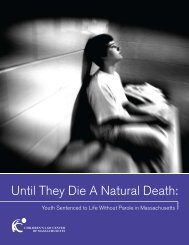States rethink 'adult time for adult crime' - the Youth Advocacy Division
States rethink 'adult time for adult crime' - the Youth Advocacy Division
States rethink 'adult time for adult crime' - the Youth Advocacy Division
You also want an ePaper? Increase the reach of your titles
YUMPU automatically turns print PDFs into web optimized ePapers that Google loves.
Teen Brains on Trial: Science News Online, May 8, 2004<br />
The results in <strong>the</strong>se small experiments remain preliminary. Even if <strong>the</strong> findings<br />
hold up, it's not clear whe<strong>the</strong>r young teens' difficulties in discerning fearful<br />
expressions stem from incomplete brain development or reflect unique duties<br />
assumed by <strong>the</strong> frontal lobes during adolescence. What's more, teenagers<br />
and <strong>adult</strong>s have yet to be similarly tested with faces displaying emotions o<strong>the</strong>r<br />
than fear.<br />
Baird's ongoing research suggests that <strong>the</strong> teen frontal brain indeed responds<br />
to spontaneous emotional expressions on <strong>the</strong> faces of friends and family<br />
members. "Kids say that <strong>the</strong> posed expressions we show <strong>the</strong>m look kind of<br />
weird," Baird says.<br />
O<strong>the</strong>r evidence suggests that mental efficiency in solving emotion-related<br />
tasks—indicated by <strong>the</strong> <strong>time</strong> taken to answer <strong>the</strong>m correctly—suffers with <strong>the</strong><br />
arrival of puberty, when gray matter volume in <strong>the</strong> frontal lobes hits its peak,<br />
according to Robert F. McGivern of San Diego State University.<br />
Response speed improves gradually after puberty and stabilizes at around<br />
age 15, a <strong>time</strong> when substantial neural pruning and myelin expansion in <strong>the</strong><br />
frontal lobes have already occurred, McGivern and his colleagues reported in<br />
2002.<br />
The researchers had studied 246 youngsters, ages 10 to 17, and 49 young<br />
<strong>adult</strong>s, ages 18 to 22. In one trial, participants saw a series of faces with<br />
various posed expressions—happy, angry, sad, or neutral—after being told to<br />
answer "yes" if <strong>the</strong>y saw a happy face and "no" <strong>for</strong> all o<strong>the</strong>rs. Each face<br />
appeared <strong>for</strong> only a fraction of a second.<br />
The participants <strong>the</strong>n completed three additional trials in which <strong>the</strong>y were told<br />
to answer "yes" <strong>for</strong> angry, sad, or neutral faces.<br />
Girls responded to <strong>the</strong>se problems more slowly at ages 11 and 12 than <strong>the</strong>y<br />
did at age 10, while boys took longer to answer at age 12 than <strong>the</strong>y did at<br />
ages 11 or 10. These declines closely corresponded to puberty's onset in<br />
each sex, McGivern says.<br />
Cycles of brain growth in boys and girls, which are <strong>time</strong>d differently during<br />
adolescence, some<strong>time</strong>s aid and some<strong>time</strong>s hinder mental dexterity in<br />
detecting various emotions, in McGivern's view.<br />
Risky business<br />
Scientists are also beginning to probe <strong>the</strong> brain's contributions to teenagers'<br />
penchant <strong>for</strong> risky and impulsive behaviors, such as experimenting with illicit<br />
drugs. Preliminary data indicate that, while playing a simple game to win<br />
monetary prizes, adolescents exhibit weaker activity than young <strong>adult</strong>s do in a<br />
brain region that scientists consider to be crucial <strong>for</strong> motivating ef<strong>for</strong>ts to<br />
obtain rewards or attain goals.<br />
A team led by James M. Bjork of <strong>the</strong> National Institute on Alcohol Abuse and<br />
Alcoholism in Be<strong>the</strong>sda, Md., used fMRI to scan <strong>the</strong> brains of 24 people, half<br />
between ages 12 and 17 and <strong>the</strong> rest between 22 and 28. Brain<br />
measurements were taken as <strong>the</strong> participants decided whe<strong>the</strong>r to press a<br />
button upon seeing various visual cues, only one of which <strong>the</strong>y had been told<br />
to respond to. On some trials, correct answers yielded prizes of 20 cents, 1<br />
dollar, or 5 dollars. On o<strong>the</strong>rs, correct answers prevented losses of those<br />
amounts.<br />
file:///L|/JDN/Brain%20Resources/Brain%20Development/Mailing%20Packet/10.%20Teen%20Brains%20on%20Trial.htm (4 of 9)8/16/2006 4:45:04 PM





